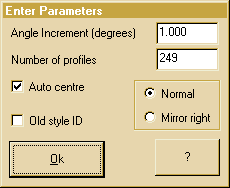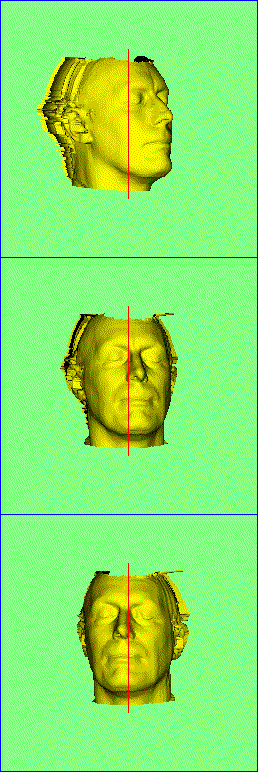Resampling to LSM format
 This
option performs a virtual laser scan of the current object, saving it in
the UCL proprietary .LSM format. In order to get a successful conversion,
the object must be suitably positioned in the centre of the window at an
appropriate scale and orientation. The orientation must be selected by
the user prior to conversion. There is an automatic centreing and
scaling option within the conversion process but this is not guaranteed
to to produce the best position for the scan. In the event of positioning
problems, it is possible to position and size the object manually before
conversion. It is then necessary to disable the automatic positioning process
within the conversion dialog box.
This
option performs a virtual laser scan of the current object, saving it in
the UCL proprietary .LSM format. In order to get a successful conversion,
the object must be suitably positioned in the centre of the window at an
appropriate scale and orientation. The orientation must be selected by
the user prior to conversion. There is an automatic centreing and
scaling option within the conversion process but this is not guaranteed
to to produce the best position for the scan. In the event of positioning
problems, it is possible to position and size the object manually before
conversion. It is then necessary to disable the automatic positioning process
within the conversion dialog box.
The dialog box also allows control of the number of profiles
and the angular spacing between them. The total angular range of
the scan = angle increment * (no of profiles -1). This is symmetrically
divided either side of the initial view so that the middle profile is at
the front. To ensure that this profile is in the middle, an odd number
of profiles is always used. If an even number of profiles is entered, this
will be rounded down to the nearest odd number. If the mirror option
is checked, then only the right side of the object is scanned and the left
side of the resulting scan will be a mirror image of the right side. Great
care with positioning and orientation is necessary for this to give a good
result so the automatic positioning is unlikely to be adequate.
 As
the conversion proceeds, a red line on the screen shows the region of the
object which is being scanned. This is a simulation of the physical scanning
process and has the same 'line of sight' limitations. Hidden surfaces will
be lost in this conversion process.
As
the conversion proceeds, a red line on the screen shows the region of the
object which is being scanned. This is a simulation of the physical scanning
process and has the same 'line of sight' limitations. Hidden surfaces will
be lost in this conversion process.
Checking the Old style ID box allows the saving of an old version
of the .LSM header for backwards compatibility
Back to index
©2008 Robin Richards, All rights reserved.
 This
option performs a virtual laser scan of the current object, saving it in
the UCL proprietary .LSM format. In order to get a successful conversion,
the object must be suitably positioned in the centre of the window at an
appropriate scale and orientation. The orientation must be selected by
the user prior to conversion. There is an automatic centreing and
scaling option within the conversion process but this is not guaranteed
to to produce the best position for the scan. In the event of positioning
problems, it is possible to position and size the object manually before
conversion. It is then necessary to disable the automatic positioning process
within the conversion dialog box.
This
option performs a virtual laser scan of the current object, saving it in
the UCL proprietary .LSM format. In order to get a successful conversion,
the object must be suitably positioned in the centre of the window at an
appropriate scale and orientation. The orientation must be selected by
the user prior to conversion. There is an automatic centreing and
scaling option within the conversion process but this is not guaranteed
to to produce the best position for the scan. In the event of positioning
problems, it is possible to position and size the object manually before
conversion. It is then necessary to disable the automatic positioning process
within the conversion dialog box.  As
the conversion proceeds, a red line on the screen shows the region of the
object which is being scanned. This is a simulation of the physical scanning
process and has the same 'line of sight' limitations. Hidden surfaces will
be lost in this conversion process.
As
the conversion proceeds, a red line on the screen shows the region of the
object which is being scanned. This is a simulation of the physical scanning
process and has the same 'line of sight' limitations. Hidden surfaces will
be lost in this conversion process.